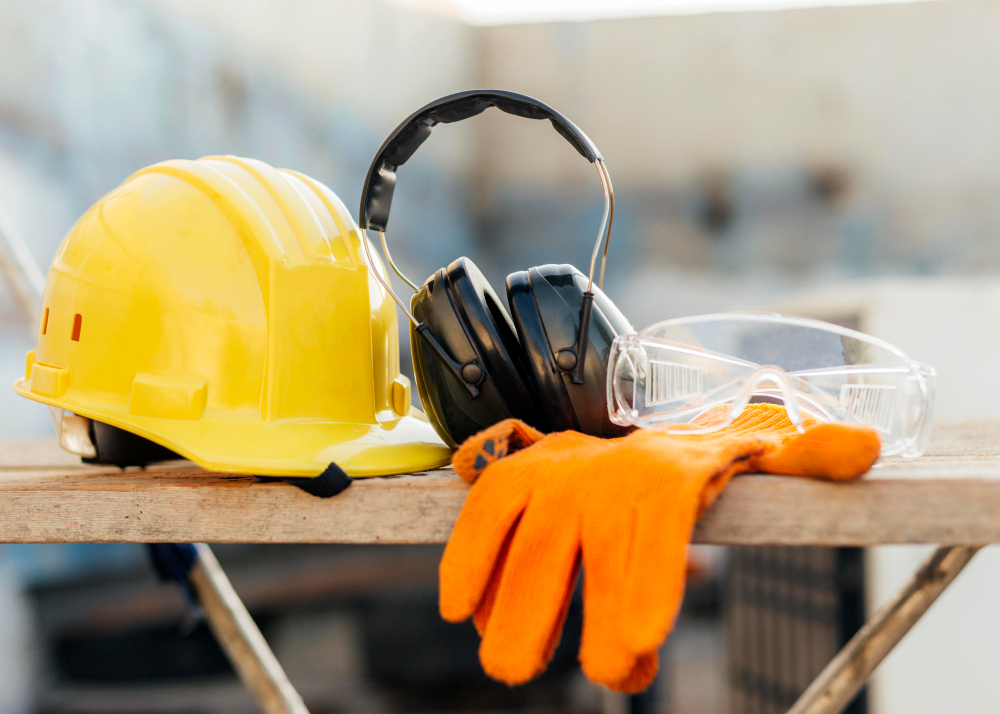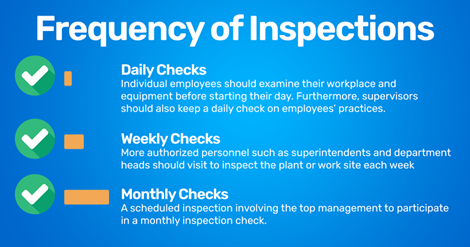What Are Safety Inspections?

This guide on safety inspections is presented by Resco.net as a leading provider of customizable solutions for MS Dynamics 365, Salesforce, and more.
Safety inspection (also called safety audit) is an on-site monitoring aimed at identifying potential problems that could jeopardize the health and safety of workers at workplaces or buildings.
A safety inspection is mostly carried out by a safety specialist and usually involves checklists, which help the inspectors in assessing every potential issue. Every step of the inspection process must be carefully documented.
Safety inspections can differ in form based on the environment in which they are done. A safety inspection can be done to check vehicle safety, industrial plants, or office buildings.
Free H&S checklist
Use our free Health & Safety template to digitize your inspections without hassle
Inspections can be announced in advance or not, i.e., be a surprise inspection. In case it’s announced, organizations have a chance to fix things that might not pass the inspection.
However, a surprise inspection can give inspectors a more accurate picture of the typical condition of the assessed area.
Following the inspection, the responsible person (personnel, supervisor, building coordinator, etc.) is contacted to correct the damages. These corrections can prevent potential future injuries, incidents, and more severe property damages.
There are several types of inspections, such as:
- Safety tours = general inspection of the workplace.
- Safety sampling = detailed and thorough inspection of dangerous activities, areas, or processes.
- Safety surveys = general inspection of dangerous activities, areas, or processes.
- Incident inspections = examining potential causes of accidents and/or injuries.
Benefits of safety inspections at a workplace:
- Increases employee satisfaction, as regular checks give employees an increased sense of safety.
- Companies can save money: When assessing the condition of equipment, inspectors can point out when something needs repair, even if only a minor one. Otherwise, a piece of equipment might be in use for a longer time until the damage is noticed, which in the end results in higher costs for repair. Not even mentioning the potential risk a piece of damaged equipment may mean for the employees.
- By preventing injuries, a company can also prevent related lawsuits, which again, in the end, can save them a lot of money.
- Regular inspections create a high-performance safety culture across the workplace.
Why are safety inspections so important?
In the UK, slipping and tripping are identified as the single most common causes of major injuries in workplaces, often leading to other types of accidents such as machinery mishaps, scalding, and falls from height1. Notably, 37% of all reported workplace injuries and 28% of all workplace fatalities result from slips, trips, or falls. On average, these incidents cause approximately 50 deaths annually in the UK, with a significant number of individuals sustaining critical injuries2.
Between 2017 and 2020, nearly 971,000 working days were lost to injuries from slips, trips, and falls, which on average, translates to 8.5 days lost per case. Furthermore, 20% of these injuries led to employees taking off work for three or more days3. During the 2020/21 period, out of 441,000 workers who suffered non-fatal injuries, 41% of these incidents were attributed to slips, trips, or falls4.
More recent data from 2021/22, as reported under the Reporting of Injuries, Diseases and Dangerous Occurrences Regulations (RIDDOR), reveals that slips, trips, or falls on the same level accounted for 33% of the non-fatal injuries, making them the most common type of workplace accident during this period5.
This comprehensive data from various sources underscores the significant impact of slips, trips, and falls on workforce safety and organizational productivity in the UK.
Types of Workplace Hazards
Safety inspections are carried out to avoid workplace hazards in the first place. Some common workplace hazards include:
- Biological hazards are caused by bacteria, fungi, and parasites.
- Safety hazards arising due to unsafe working practices
- Chemical hazards caused by dust, mist, and gas
- Physical risks occurring due to vibration, heat, radiation, and pressure
- Ergonomic hazards arising due to improper posture and working methods
- Psychosocial hazards related to mental health or well-being issues.
How often should safety inspections be performed?
The frequency of inspections can vary depending on the workplace but carrying out a risk assessment is a great way to identify it. A risk assessment is a systematic method of looking at work activities, considering what could go wrong, and deciding on suitable control measures.
If inspections are carried out monthly, but issues are rarely found, it is probably enough to do it every two or three months. However, if issues are found during every inspection, you should definitely do them more often.
Who Should be in the Inspection Team?
Union-appointed health and safety committee members are the obvious choice for carrying out inspection checks in a workplace.
A selection criterion may include experience level, knowledge about the regulations, and potential hazards.
Engineers, maintenance personnel, supervisors, and managers are possible candidates for the inspection team.
Safety inspection legislation
Legislation nearly all around the world places a duty on employers to ensure the health and safety of all employees at the workplace. In general, employers must provide training, instruction, information, supervision, a safe workplace, safe entry and exit, safe machinery, equipment, and methods of work.
Regularly performing inspections can help you identify whether your local legislative requirements are being met.
Duration of the Inspection
There isn’t a specific time duration for the safety inspection. Usually, it depends upon the findings, the organization’s size, and the number of questions asked.
Simply put, if you want to classify your organization as entirely safe, it’s better for the inspection team to thoroughly inspect the machines and processes rather than having a quick look.
How Should Inspections be Carried Out?
The process is straightforward: the inspection team has to observe the workplace and identify or note any negligence in the work practices. Some poor work practices that may be a cause of concern include:
- Using machines without authority
- Not wearing PPE (Personal Protective Equipment)
- Unsafe sanitary conditions
- Working or standing under suspended loads
- Adjusting machines when in a state of motion or electrically charged
- Improper handling of machines
Furthermore, the inspection team should follow the basic principles during an inspection. Some major ones include:
- Check machines when in static mode
- Avoid operating yourself and check if the operator is aware of the dangers associated with inadequate handling
- Carry a thorough and all-around inspection
- Ask questions without disrupting work activities
- Note each hazard in your rough notes
Importance of Follow-Up and Monitoring
A follow-up inspection is necessary if the organization was obliged to take corrective actions in the previous inspection check.
In essence, it’s a review to identify whether the organization implemented solutions to prevent potential loopholes as specified in the initial safety check.
But why is it so important?
Safety inspection saves lives and prevents your business from facing a lawsuit on account of poor working conditions.
So, if you cut corners regarding your business’s safety protocols, remember that you’re hurting your business reputation.
Difference between Safety Inspections and Safety Audits
Although both have the primary goal of ensuring the organization’s safety, there are plenty of differences.
Firstly, a safety inspection involves looking for hazards and risks that may affect a business’s safety. In contrast, a safety audit examines whether the safety programs and strategies meet the business’s long-term outlook.
Secondly, safety inspections are usually carried out by the organization’s personnel, while external agencies conduct safety audits for a business.
Everything to Know About Frequency of Inspection

It’s recommended to carry out a safety inspection check after every six months. However, self-inspection within the organization should be carried about almost daily.
If you’re unaware, a self-inspection involves everyone from the top management to the frontline worker to ensure that adequate working protocols are followed.
Here’s a breakdown of the frequency:
- Daily Checks: Individual employees should examine their workplace and equipment before starting their day. Furthermore, supervisors should also keep a daily check on employees’ practices.
- Weekly Checks: More authorized personnel such as superintendents and department heads should visit to inspect the plant or work site each week.
- Monthly Checks: A scheduled inspection involving the top management to participate in a monthly inspection check.
How to make the most out of your safety inspections?
Time is money, and this is especially true when it comes to inspections. Safety inspections are extremely important but can also be very time-consuming. Therefore, a crucial question to ask before setting up your inspection processes is: How can you make it as time- and resource-efficient as possible?
The answer? Turn the power of technology to your advantage. Replace the paper-based inspection processes with a digital solution, making the flow of information much faster and simpler.
Machines, materials, methods, and even people can fail – and they do fail regularly. That’s why regular inspections are a must. This is especially true for manufacturing plants and factories, where the risk of accidents is the highest. In an environment where inspections are performed on a daily basis, making them time-efficient is essential.
Resco Inspections features, such as snapping pictures, scanning product codes, image recognition, and voice control can help you speed up the safety inspection process, while also reducing related costs.
Another critical challenge in modern manufacturing is that the documents are paper-based, which results in endless piles of paper that need to be archived or transcribed into digital format.
Resco Inspections makes your inspection processes more effective by enabling you to have all your data in one centralized hub straightaway – making it easier and quicker to keep track of all collected information.
Free H&S checklist
Use our free Health & Safety template to digitize your inspections without hassle
I want the H&S checklist template
Furthermore, it gives you more control over the entire safety inspection process – it allows you to design, schedule, execute, and analyze all your forms and processes.
Resco Inspections helps to ensure not only the safety of workers but that of the inspectors too. Their hands can be free as they don’t have to carry the paper forms with themselves everywhere, allowing them to fully focus on their work.




